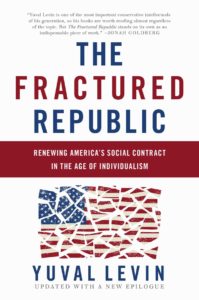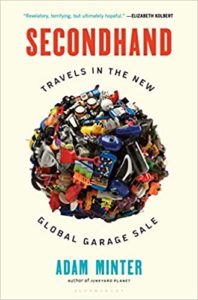 Description
Description
Americans today are anxious—about the economy, about politics, about our government. The institutions that once dominated our culture have become smaller, more diverse, and personalized. Individualism has come at the cost of dwindling solidarity. No wonder, then, that voters and politicians alike are nostalgic for a time of social cohesion and economic success.
But the policies of the past are inadequate to the America of today. Both parties are stuck presenting old solutions to new problems. In The Fractured Republic, Yuval Levin details his innovative answers to the dysfunctions of our fragmented national life. By embracing subsidiarity and diversity and rejecting extremism and nostalgia, he believes we can revive the middle layers of society and enable an American revival.
My Summary
Though only 272 pages long, this book took me more than a month to read, partly due to remodeling and other side projects, but mostly because it’s a “thinking” book. Hardly a page went by without causing a new realization, making a pointed reminder, or bringing up an excellent suggestion.
I cannot recommend this book enough: it gives a framework for understanding much of our current political climate without specifically assigning blame, and offers convincing suggestions for remedying it.
The first half of the book looks at some history from the 1950s through the present, pointing out specific different areas that those on the Left and Right embrace and would like to bring back, and the second half makes a number of suggestions for moving forward.
Below is a basic outline of the book, along with a number of quotes and thoughts that really stuck out to me.
Part I: Out of One, Many
Chapter 1: Blinded by Nostalgia
The Left and Right both long for specific time periods from the past half century and strive to return to the benefits they see from those times: “Democrats talk about public policy as though it were always 1965 and the model of the Great Society welfare state will answer our every concern. And Republicans talk as though it were always 1981 and a repetition of the Reagan Revolution is the cure for what ails us.” (page 15).
This nostalgia blinds us to many of the changes that have taken place in our country and culture during this time period.
He also thinks that we see these years as if we were looking at the life of a person in the Baby Boomer generation:
- 1950s: wholesome and innocent (childhood)
- 1960s: idealistic and rebellious (teenage years)
- 1970s: anxious (college, starting in the workforce)
- 1980s: more stable footing (early adulthood, family and career growth)
- 1990s: comfortable and confident (mid-life success)
- 2000s and 2010s: more fearful and disoriented (older age)
This chapter alone is worth getting the book just for understanding the context of current political viewpoints, discussions, and goals.
Chapter 2: The Age of Conformity (1950s)
As the US came out of World War II, we were a strong, unified, consolidated country—partly due to rationing and the clear moral struggle we perceived between democracy and Nazism/fascism. However, Levin argues, it was a unique “bridge” between two Americas: the increasingly unified and centralized society and government in the first half of the century, and the increasingly diverse culture in the second half.
In the 1950s, much of the country was still relatively consolidated economically due to necessary regulation during the war years, and it was also a low point for immigration as well: by 1950, the percentage of US residents who had been born abroad was 7% (down from 15% in 1910) and down to just 4.7% in 1970.
Progressives tried to “alleviate the plight of industrial workers” by opposing the consolidated government and company ownership with consolidated workers’ unions, democratic political power, and popular cultural power.
“The Left was fighting the cultural constriction while reveling in the economic consensus; the Right was fighting the economic constrictions while reveling in the cultural consensus.” (page 53).
Chapter 3: The Age of Frenzy (1960s–70s)
The 1960s–70s saw many changes and liberalization of culture, economy, etc., with more focus on individualism and a growing distrust of big government, labor unions, and consolidated power.
In the 1970s, Republicans and New Democrats realized that liberalization was not to be resisted and they should instead work with the diffusion and fracturing.
In the 1980s and especially the 1990s, rising inequality and diversity moved people away from large cultural institutions and networks and into smaller more niche networks.
Chapter 4: The Age of Anxiety (1980s–present)
The combination of women and more immigrants expanding the workforce and new technologies driving big productivity gains resulted in a major cultural shift: (page 83)
- The weakening of our established institutions
- A growing detachment from the traditional sources of order and structure in American life
- An intensifying bifurcation of ways of living
American life continued to be concentrated, but at both ends of the spectrum (in ways that pull us apart) instead of in the middle (in ways that bring us together).
- Economically: both big and small businesses grew, but medium-sized did not
- Politically: people became more “polarized” on the extreme ends of the spectrum
- Institutionally: “increasingly, society consists of individuals and a national state, while the mediating institutions—family, community, churches, unions, and others—fade and falter” (page 89).
Not surprisingly, the Left and Right have different explanations for the societal fracturing; the Left blames it on economic equality, while the Right pins it on cultural disintegration and polarization.
Essentially, the Left sees economic change as the root of many of our current issues, while Right sees cultural change as the cause, and both tend to overlook or deny the diffusion and decentralization of society in the past half century.
A couple more pointed reminders from this chapter include these:
- Midcentury nostalgia cannot provide a guide for today’s society.
- The constitutional system is adaptable; the 1930s–1960s-style welfare state is not.
- Those on the Left must realize that consolidated power and programs are not an effective solution, and that giving more options instead of fewer is likely to work.
- The Right has it a little bit easier since they tend to emphasize mediating institutions—church, community, clubs, etc.—which offer more promise of bringing us together and making improvements, but they should not emphasize radical individualism as much as they do.
Part II: The Next America
Chapter 5: The Unbundled Market
“The Left distorts or exaggerates America’s economic problems and the Right discounts or ignores them. So what are they missing? What are those problems? …The core of what our bipartisan nostalgia obscures has to do with the effects of persistent diffusion and diversification—which in this case involves especially the effects of an intensifying specialization in our economic life.” (page 113).
Several major structural transformations have impacted society:
- Globalization
- Attempts at restraint (protectionism, tariffs, special incentives, etc.) aren’t effective because the benefits of globalization are too great.
- Automation
- The hollowing-out of the middle hurts those at the bottom more than those in the middle, because the “rungs” on the ladder to the “top” are fewer and further apart.
- Immigration
- Immigrants tend to be either highly-skilled (seeking more opportunities for advancement) or low-skilled (seeking any improvement), so immigration tends to increase economic specialization.
- Consumerization
- As workers, we want better pay and options, while as consumers, we want lower-cost goods and services.
- Employers used to mediate the tension, because the needs of workers took priority over the needs of consumers.
- Increasingly, we view ourselves as consumers rather than workers, and the shift in mindset has caused companies to shift and prioritize consumers’ needs over employees’ needs.
Some potential solutions:
- Address income inequality.
- Don’t mistake it for a cause as much as an effect of other causes.
- Make it easier to earn a decent living wage by improving the tax/regulatory system, making healthcare more competitive and affordable, reducing cronyism, and reducing bottlenecks (requirement for college education to get a job, etc.).
-
“If the Left is to help America modernize, and lift up those Americans made most vulnerable by the trends we have been following, it will need to free itself from the anachronism of social democracy.” (page 130).
- Re-evaluate social democracy.
- The welfare bureaucracy is a relic of a bygone age of consolidation. Instead, we need alternatives that help integrate those who need help into society and those mediating institutions of family, church, community, etc.
- To those on the Right: don’t fight to roll back or shrink liberal welfare state, but seek to “replac[e] their centralized administrative forms with decentralized mechanisms of knowledge discovery at the margins” (page 141).
- To those on the Left: “advocate for public provision as an option in the resulting competitive markets to restrain the excesses of market provision and serve the unmet needs of the most vulnerable” (page 141).
- Decentralize social and economic policy.
- If we strengthen the markets, we should also strengthen those subsidiary/mediating institutions that help counteract the negative effects of markets.
Chapter 6: Subculture Wars
As “expressive individualism” leads to more specific cultural niches, the centralized mainstream institutions are giving way to more specialized self-selected networks.
Social conservatives for a long time “could plausibly believe that their views about the ideal firms and norms of society were in fact very widely shared” (page 156), while recognizing that many people failed to live up to them. They could see themselves as a “‘moral majority,’ overtly opposed only by a small if influential sliver of radical cultural elites.” (page 157). Increasingly they must—and have—realized that they cannot expect the political system to fit their views.
“Convictional believers” numbers have not changed much, but nominal Christians are becoming unaffiliated. “Many have ceased to view religious traditionalism as an ideal with which to nominally identify and have come instead to see it as an option to reject.” (page 159).
Religious traditionalists no longer speak for the majority or set the standard, and are out of practice defending it. They tend to lament what has been lost more than what might be gained.
The Left looks ahead and sees economic collapse; the Right, moral collapse.
“All sides in our culture wars would be wise to focus less attention than they have been on dominating our core cultural institutions, and more in building thriving subcultures.” (page 165).
Religious liberty has become the “chief rallying cry” for conservatives and is essential, but not sufficient.
- It is an “almost exclusively defensive posture”, asking to be protected and left alone rather than selling others on their vision.
- It “risks further distorting the larger public’s understanding of what is at stake in the culture wars,” tending to focus predominantly on sexuality, partly because that is mainly what the Left has been attacking.
- It “gives social liberals far too much credit and leaves social conservatives far too despairing” (pages 170–172).
“Expressive individualism, if taken all the way to its logical conclusions, points toward moral chaos, and moral traditionalists are therefore its natural critics and opponents.” (page 172).
“In our time, the greatest threats facing social conservatives come not from the profusion of moral practices and views in American life, but from the efforts of some on the radical Left to use liberal-dominated institutions (from the federal bureaucracy to universities, the mainstream media, and much of the popular culture) to suppress and exclude traditionalist practices and views.” (page 173)
The best method to fight back is to build genuine, caring communities, rebuilding the mediating institutions and “keeping things at the human scale.” (page 176).
“Those seeking to reach Americans with an unfamiliar moral message must find them where they are, and increasingly, that means traditionalists must make their case not by planting themselves at the center of society, as large institutions, but by dispersing themselves to the peripheries as small outposts.” (page 178).
Centralized national policies cannot fix the diffuse issues and problems in society. Genuine human connections and community (and the Gospel) can address individual needs, and perhaps we need to grow a new national identity from the bottom up.
Chapter 7: One Nation, After All
This nostalgia for mid-century America blinds us to its bad effects, causes us to keep trying the same formulas, and hinders us from seeing solutions to the very different conditions we have now.
We should use the multiplicity of our society rather than seeing only two binary options of consolidation and individualism. “As a centralized government [the favored solution of the Left] draws power out of the mediating institutions of society, it leaves individuals more isolated; and as individualism [the favored solution of the Right] further erodes the bonds that hold civil society together, people conclude that only a central authority can pick up the slack. That dangerous feedback loop keeps us from seeing the possibility of other sorts of solutions to the problems we face.” (pages 186–87).
“[T]he distinctive political failures of our era are functions of increasingly centralized administration in an increasingly decentralized society.” (page 187)
- Left: defends centralizing government
- Right: defends radical individualism
“Their arguments are, in effect, about whether our government should do more or less of the same, and it is not hard to see why the public often finds these debates pointless.”—p187
“[I]nstead of applying their increasingly distinct worldviews to contemporary problems, each party has tended to understand its own increased coherence as an argument for persisting in old policy ideas—for completing the inherited checklists of the Right or Left. Each party so powerfully identifies its political objective with a particular moment in the past that neither is inclined to apply its insights to today’s different circumstances. The name of this problem is nostalgia or anachronism, not polarization.” (page 189; emphasis mine).
The past half-century has seen a growth in personal liberty, as defined by the Left: “the individual’s freedom from coercion and restraint—in essence, the freedom to shape one’s life as one chooses” (page 199), with these limits:
- Material/economic: the rich have more options than the poor; they try to address that by redistributing wealth.
- Social/traditional: there has been a huge shift from traditional values to individual ideas of family, sexuality, and culture; they try to address this by promoting pluralism.
- Political: powerful interests abuse the weak, enforcing their views on moral dissenters; they try to address this by limiting power of those on top (campaign finance reform, free speech, etc.)
The Right’s definition of liberty “is mediated by the concept of rights, and especially property rights.” (page 201).
- “Government redistribution of property can directly impinge on our rights of ownership, and so can easily be seen as unjust.” (page 201)
- The “highly individualist conservative idea of liberty is less concerned with giving different people equal power to make their choices matter, and more concerned with letting every individual do what he wishes with what he has—provided he does not take from others. This is an ethic of protection rather than provision.” (page 201, emphasis mine)
Both definitions take for granted the idea of the free human person; the free human informed and capable of using their freedom well is a great achievement socially and has not been seen much throughout world history.
“The liberty we can truly recognize as liberty is achieved by the emancipation of the individual not just from coercion by others but also from the tyranny of his unrestrained desires.” (page 203) This requires moral formation by those middle institutions which are pulled apart from above and below:
- Family: teaches fulfillment of responsibilities and expectations
- Work: provides material needs but also “buttresses dignity, inculcates responsibility, encourages energy and industry, and rewards reliability.” (page 204)
- Education: can form our souls by granting glimpses of artistic genius
- Civic engagement: helps us realize limits
- Religious institutions: the “ultimate soul-forming institutions” teach responsibility, sympathy, lawfulness, righteousness
Not everybody has access to these institutions, and reinforcing, sustaining, and “especially putting them within the reach of as many of our fellow citizens as possible must be among our highest and most pressing civic callings.” (page 205)
Buy the book→











